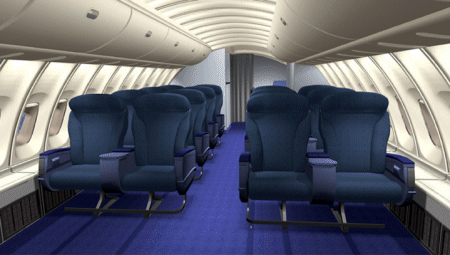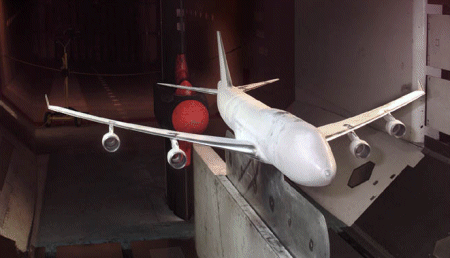Guy Norris/SEATTLE
Boeing is close to deciding whether it is better in business terms not to stretch the 747, or to develop the 747X and oppose Airbus. At a dinner in Seattle in June, a week before Airbus received authority to offer the A3XX, Boeing president Alan Mulally said, with a glint in his eyes: "I really can't wait for them to launch their programme."
What did Mulally mean? Is he suggesting that Airbus is digging its own grave by finally committing to the massive A3XX project, or is it a clear sign that the go-ahead of the big competitor provides Boeing with the best excuse yet to develop the 747X family? Perhaps both -yet as Boeing always says, it does not react to Airbus, it reacts to the customer - and the Seattle giant appears to be doing its homework when it comes to listening to the airlines.

The US manufacturer has decided to tackle the all-new A3XX family with advanced derivatives of its 35-year old 747. Although this seems to set Boeing at a disadvantage to its 21st century rival, in reality the company expects to create a very competitive family for a third of the cost of the $12 billion A3XX, and provide existing 747 operators with commonality benefits.
Phil Condit, chairman of the Seattle-based manufacturer, recently intimated that Boeing could give the $4 billion 747X programme a green light within six to nine months, and is targeting up to 30 launch orders from three customers. The 500-seat 747X Stretch will be the first of the new larger models to in service, in the second half of 2005.
747X effort
Leading the 747X effort is John Roundhill, vice-president for product strategy and development, who says: "I sleep really well at night knowing we are working with the airlines. It's a big plan, but quite honestly I'm not intrigued with any of it unless they are." Boeing's "big plan" has mutated out of all recognition since its last serious attempt to stretch the 747 with the -500X/600X ended in failure and sleepless nights all round. "We can't afford to let it happen again like that. We need to come up with an aircraft the customer values enough that it is a success, even if with the A3XX," he adds.
On that point Roundhill accepts the inevitability of an A3XX launch, at least from a planning perspective. Despite its inability to get ahead of Airbus with a 747 successor in the 1990s, Boeing does not appear to be dismayed. "Some airlines are still a little nervous about having something as early as 2005," says Roundhill, who suggests that the early 2000s is the right timeframe for such a development. Boeing's latest market predictions now suggest a requirement for around 360 aircraft sized for 500 seats or more over the next 20 years.
Target market
The main target, however, continues to be the 400-plus seat arena where Boeing sees a larger market for 560 aircraft. Taken as a whole, Boeing believes it will fight Airbus for a market of between 900 and 1,000 aircraft over the next 20 years. Out of this, and the torturous passage of the 747 product development studies over the past 10 years, has evolved a familiar family plan with a few notable new twists.
"We're thinking about this more and more as a family," says Roundhill, who adds that the initial "stepping stone" remains the near-term development of a higher gross weight 747-400X. Offering a maximum take off weight (MTOW) up to 413,000kg (910,000lb), the aircraft will offer more in terms of flightdeck and interior changes than the similar higher MTOW variant first mooted in late 1997. "It would have the same new interior and new flightdeck, and we are also looking at upgrading its built-in test equipment maintenance system," he says. The heavier weight allows 747-400 operators to fly a further 925km (500nm) with a full payload, lifting current restrictions on some key routes such as Los Angeles-Sydney, London-Singapore, Los Angeles-Hong Kong and Chicago-Hong Kong.
Although the -400X would use the thicker gauge -400F wing, it will not have the 747X's aerodynamic changes. "The customers want it soon, so that would have pushed it out," Roundhill says. If launched this year, Boeing says it could deliver the first aircraft in the third quarter of 2002. "The main reason we can do it so fast is that we have already done a fair amount of work on it, particularly for the Asian market. It is relatively modest as far as development programmes go." The project is being staffed in anticipation of launch this year.
Design modifications
Structural changes needed for the -400X provide the basis for some of the far more significant design modifications planned for the 747X family. This builds around a new wing box, to which larger wing roots will be attached, and a stretch of the fuselage fore and aft to create the 504-520-seat (three class) 747X Stretch.
This model would then give birth to a new series of derivatives which will form the basis for a "Next Generation 747" family. These include a 747X Stretch freighter, which "will have the same volume and payload as the A3XX-100F and which I wouldn't be surprised to see us do first," says Roundhill.
Another would be the 660-seat 747X Stretch domestic for the Japanese market, and the baseline 430-seat 747X which would fall out of the Stretch. Combining the revised wing root, wingbox and other changes of the Stretch, but not the fore and aft fuselage extensions, the 747X would slightly larger than the 747-400/ 400X and would eventually replace those models. The 747X would also provide the basis for the planned 747X Combi.
The root insert has grown from 2.2m (7.2ft) to 2.6m, providing an overall span increase of 5.3m. Boeing also planned to "re-loft" the wing-body join section, but found that by changing the profile of the entire inboard section out to the inboard engine position with 777-style aerodynamics, it created a "substantial" reduction in drag. Together with the trailing edge wedge design, which was flight tested on a 747-400F and in the windtunnel, the "new" wing has a 6% lift/drag improvement over that of the -400 wing. "We believe it's within 1% of a brand new wing," says Roundhill.
Other wing changes include the switch to a simpler, more efficient double-slotted inboard trailing edge flap from the current triple slotted item. "We may even go to a single-slotted design," says Roundhill, who says this is possible because of the increased wing area. It will also have drooped ailerons for take-off as part of efforts to keep field performance within the boundaries established by the -400, and to keep noise levels compatible with proposed Stage 4 limits. Four different wingtip treatments have been tested in the windtunnel: the standard -400 winglet, a larger version of this, an Aviation Partners Boeing blended winglet and a raked tip based on that devised for the 767-400ER and 777-200LR/300ER. A final choice was pending as Flight International closed for press.
Fuselage stretch

The 747X Stretch fuselage is extended by 9.63m with the latest changes. The tips of the vertical and horizontal tails are extended with 747SP-like area increases, and new main landing gear is required to support the aircraft's MTOW of 473,100kg.
While the concept has not altered drastically over the past six months, Boeing's competitive argument for the new family has grown stronger. "We really believe that our cost per seat mile will be lower than for the A3XX-100," says Roundhill, whose conviction is grounded on three main reasons. First, Boeing believes Airbus' cost advantage over the baseline -400 is flawed because it is based on its own optimum seat configurations - not the seating plans used by most -400 operators. "We think we know the -400, and we think we know our stretch, so we're confident in a double-digit advantage over the -400 for the X Stretch," says Roundhill.
Windtunnel tests

Second, the latest windtunnel tests have shown better than expected results, further fuelling the belief that the Stretch could have a 12-13% advantage over the -400, as well as a higher cruise speed of Mach 0.86. Third, the latest configuration contains a large overhead cabin area based on similar designs developed for the 777 twinjet. "We have really been encouraged by recent airline reviews to include this overhead area," says Roundhill.
Used for either crew rest or passenger bunk space, it provides various options, but Boeing says it frees up to 18 extra seats if used as a galley storage area. "The capacity increase over the-400 without the overhead rest is 88 seats , but with it this rises to more than 100. So we think it's definitely a 20% increase in capacity."
High-speed line freeze, the phase when the outer aerodynamic shape is decided upon, is expected by the end of this year. In the first quarter of next year, Roundhill says, "we will freeze design loads and the design of parts. We often find that's about the time when we launch programmes, although we think we could launch earlier".
Source: Flight International























